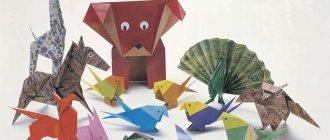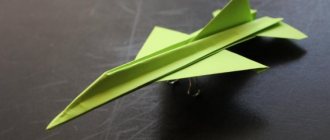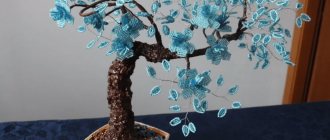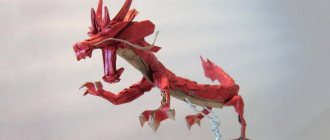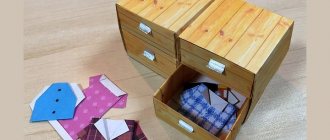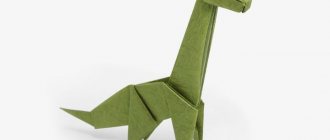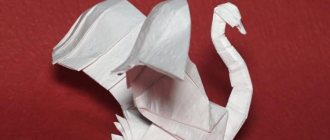An origami crow figurine made of paper is especially popular during Halloween. In the minds of Europeans, this bird is strongly associated with magic and the world of spirits. In the homeland of origami, Japan, ravens were also attributed occult properties, only here they were considered sacred messengers of the gods - otsukayami and were often used in solar symbolism. A meeting with a raven promised happiness and prosperity; it protected from misfortunes and dark forces. In this aspect, a paper figurine of a bird can even be considered as a kind of amulet.
Simplified version
The model is ideal for a postcard. Assembled based on the basic “Fish” shape. This origami crow is ideal for children from 6 to 7 years old. It has a simple design and folds up in just 14 steps.
Step-by-step instruction:
- A square with a side of 15 - 21 cm, place the top towards you.
- Fold in half from top to bottom and open.
- We bend the right and left sides of the lower part towards the middle line.
- Repeat the same for the top part.
- Open the resulting pockets.
- We get the basic shape “Fish”.
- We bend the inner corners of the triangular valve outward, as shown in the figure. We remove the upper half of the figure back.
- Turn the product over.
- We lift the top layer up along the line indicated in the figure.
- Fold the workpiece in half into a “mountain”.
- We tilt the upper corner down diagonally and “flatten” it into a rhombus.
- We design the bird's head. We make a zigzag, emphasizing the massive raven beak. Then we bend the “head” a little in the center, giving it volume.
- Glue on or draw eyes.
How to make a crow out of paper?
The first step is to make a cone out of black cardboard. To do this, use a compass to draw a circle on paper. Its value depends on the size of the crow you need. In any case, from a circle covering the entire width of A4 cardboard, a cone approximately 10 cm high is obtained.
Draw a circle, divide it crosswise into 4 even parts. Depending on how many parts will be involved in the work, the width of the cone is determined. That is, if you cut off one part, the cone will be wide. The cone for the crow needs to be quite narrow, so you need to cut 2.5 parts from the circle. And make a cone from the remaining 1.5. In the photo, the sector of the circle that we need for the craft is indicated in red.
Cut it from the circle.
Roll into a ball and glue the sides together. The base of the crow is ready, now let's move on to the small details.
Draw on black cardboard, or first on white paper, a round head with forelock, tail and wings, cut out. The wing can be drawn on one side only, then fold the paper in half and cut out two identical parts at once.
Cut out a diamond-shaped beak and legs from yellow paper. Make the paws longer, taking into account the fact that later they will need to be folded into an accordion.
The components of the paper crow are ready, it’s time to move on to assembling the bird.
To do this, glue the eyes and beak to the head. Note that the sides of the beak should be at the edge of the head. The beak itself is slightly folded and pressed in the middle and glued only on the sides and in the upper part. Glue the crow's head and tail.
Attach the wings to the back of the cone.
Fold the paws into an accordion.
Glue them inside the bottom of the cone.
That's it, the paper crow is ready.
Isn't she funny? An origami crow
is another classic
model of a “talking” origami figurine
.
Children can put a paper crow figurine on their fingers and, by moving their fingers, make the crow open or close its beak, creating the impression that the crow is talking. Another similar diagram of a “talking” origami
is on our website - this is an origami fox, but a little simpler. This model is also convenient in that it uses a regular notebook sheet as its basis. Therefore, origami crow is very popular among school-age children.
"Talking" crow
For home puppet shows, there are no better origami artists. They are easy to make yourself with your children, saving time and materials. Not only Krylov’s popular fable, but also other productions cannot do without a crow. The colorful bird is the heroine of many folk tales. But in order for an origami model to be able to easily “caw at the top of its lungs,” it must be assembled according to a special pattern.
You will need a sheet of paper measuring 21x21 cm, with sides of different colors: black and white.
Step-by-step instruction:
- Fold the square diagonally.
- Bend the left corner to the right and open the workpiece.
- Place the triangle with its apex down. Bend the right and left corners to the central axis.
- Turn the workpiece at an acute angle upwards. We “spread” the lower points to the sides.
- We open the workpiece and along the marked lines, turn it inside out, white side up.
- We lower the acute angle down until it touches the base.
- Fold the piece from the previous step up and to the right.
- We do the same with the second acute angle.
- This is the beak of our crow.
- We turn the upper and lower parts in the opposite direction.
- Fold the workpiece in half into a “mountain”.
- Draw the bird's eyes and feathers with a felt-tip pen.
The heroine of the home performance is ready to go out. In order for it to open and close its beak, you need to pull both wings at the same time.
A slightly different way of assembling an origami crow is shown in the video:
Origami crow simple diagram - Origamir
ORIGAMI - ANIMALS.
Sheep, crayfish, horse, seal, hippopotamus, bunny, sparrow, dachshund, cow, turtle, fish, pelican, rabbit, toad, swallow, wild boar, flying squirrel, dog, crow, seagull, bear cub, raccoon, killer whale , stingray, rhinoceros, squid, giraffe, fox.
Origami. How to make a sheep.
A very simple, soft pink sheep will be made from a square of colored paper.
Paper origami . Cancer is another interesting craft for children
Origami assembly - horse. A simple paper craft for kids. My daughter will be happy to make such a craft.
Assembling origami - Navy Seal. This simple craft will be interesting for children. Prepare a square sheet of paper and see the diagram
Clicking Beak
A funny model, although somewhat unusual. Instead of a whole figurine, you will only get an origami crow beak that opens and closes, while clicking loudly. Children will definitely love this toy, especially since they can make it in literally a minute. You need to take thick paper, for example, office paper, only then the beak will be able to produce a clear and strong sound.
Step-by-step instruction:
- Fold the A4 sheet in half in the transverse direction.
- And fold it in half again. Unfold the free side away from you.
- Open the last fold. We fold the lower corners of the workpiece towards the central axis.
- We do the same with the top ones.
- Turn the workpiece over.
- Fold the remaining top corners towards themselves.
- We bend the workpiece in half “mountain-wise”. We mark the middle.
- Cut along the 1 cm mark.
- We bend the edges into a triangle.
- We open the workpiece and connect its two halves.
Diagram of an origami crow opening its beak:
Video tutorial with detailed description:
From scrap materials
Do you want to know how to make a crow from paper and scrap materials? Then take:
- A toilet paper roll.
- Glue.
- Scissors.
- Sample.
- Black paper.
What do we have to do:
- Print the template. Although you can draw the details yourself, it is not difficult.
- Cut out the pieces.
- Cover the sleeve with black paper.
- First glue the crow's belly, then the nose and eyes. Glue the tail on the other side.
- To make it look like a crow is in flight, glue the wings to the back of the body, pointing them in different directions.
- Bend the legs and glue the bottom to the inside of the sleeve.
It turned out to be a fun crow for playing theater!
Crows in Japanese culture
Majestic black birds in the Shinto religion were considered the messengers of the primordial gods Izanami and Izanagi, the creators of the earthly world. An interesting ritual is associated with them, which was carried out until World War II in one of the largest sanctuaries, Taga-taisha (Shiga Prefecture). On certain days, temple servants presented the ancestor deities with a treat of boiled rice - shinsen. But before preparing the ritual dish, the still raw grains were offered to the crows that lived in the surrounding area.
A loud clap of the hands served as a signal to the birds about the appearance of their favorite delicacy. As soon as the crows flew in and began to peck at the rice, the priests realized that the gods were ready to accept the offering and cooked the grains for the temple ceremony. At other shrines it was customary to treat divine messengers to mochi rice cakes. According to a legend common among the servants of the Ookuni-tama-jinja temple in Tokyo, for many years a white crow flew to them, very fond of the popular delicacy. Moreover, she appeared only on the days of ritual rites of worship of the gods, which were held on the first and fifteenth of each month. To this day, the feathered messengers of the primordial gods continue to live in temple complexes, where they are pampered in every possible way and allowed a lot.
Despite their respect, the Japanese, like many other peoples, have since ancient times treated crows with some caution. Birds were loved mainly in the northern regions of the country by the Ainu people. Here, crows were recognized as warriors and protectors of the sun, warding off any misfortunes from people. Therefore, they were allowed to fly freely near human habitation and eat whatever they found, including on dining tables. It was considered a crime to drive away, much less harm a raven in any way.
In other regions, both positive and negative superstitions were associated with black birds. They tried to appease the crows so that they would not harm humans. In some areas, there was a karasukanjo ritual, during which they were offered rice delicacies - mochi and dango. Ritual feeding took place twice a year: in autumn and spring and was closely related to the peasant agricultural cycle. When the birds flew to the table, three additional types of grain were scattered in front of them: rice, wheat and barley to tell fortunes about the harvest. Whichever variety the winged guests preferred was the one that would produce the most abundant crops.
